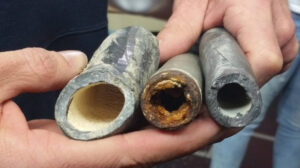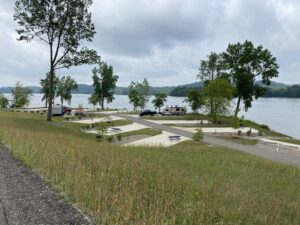
INDUSTRY TRENDS
Discovering the Unique Benefits of Redevelopment
July 10, 2019 | WRITTEN BY: Carmen
Written by: Jeremy Ousley, PE, Project Manager
There’s a special feeling about taking something old and making it new again. Whether it’s renovating a century home or restoring an old car, there’s a sense of satisfaction in rediscovering the quality of treasures from our past that have been tarnished by time. In many ways, redeveloping an old site carries the same level of significance. The unique aspect of redevelopment is that these sites not only have character, but they carry a history that can’t be mimicked. While redeveloping a site can present its own set of challenges, it also presents some unique benefits. That’s why choosing to redevelop an eyesore in the middle of town could be the best decision for the project and the community!

The Benefits of Redevelopment
- Cost and Time Savings
Oftentimes, the two most important factors for a project owner are cost and time. Choosing to build on an existing site can have positive impacts on both the pocketbook and the calendar. While an old site may not look great on the surface, what lies beneath could be a goldmine of savings. With redevelopment projects, there is a good chance the site has good bones, meaning much of the existing infrastructure is still intact and reusable. For example, if you’re reusing a site with water or sewer service across a busy intersection, the cost and time savings of reusing an existing utility connection could be invaluable.
2. Reduced Permitting Requirements
Another factor that affects the project schedule is permitting and zoning. Projects can get held up if caught in the middle of a zoning or planning dispute. By choosing an existing site with a similar use as the proposed development, it is more likely that zoning disputes can be avoided.
Design and construction permitting can be similarly relaxed. The Ohio EPA has reduced stormwater quality requirements for redevelopment sites built into their permit, and likewise, by nature of already being developed, the overall stormwater detention requirements become reduced. If existing utility connections are reusable, costly water, tap, and sewer connection fees can also be avoided.
Another time-saving key in facilitating the permitting process for any development project is getting it in front of local officials early and allowing them to provide feedback, becoming part of the project. Most local agencies appreciate the opportunity to get involved early, and it provides opportunities to foresee permitting pitfalls that could slow the development process.

3. Improvements to the Community and Environment
The right kind of redevelopment can transform entire neighborhoods. By their nature, redevelopment sites are more likely to be located within population centers as opposed to community outskirts. If the community has been staring at a dilapidated lot for years, they will likely welcome something new with open arms.
There are also many environmental benefits to redevelopment. Using a site that’s been previously developed:
-
-
- Reduces the amount of new resources required to manufacture piping, pavements and building materials;
- Reduces new land disturbance and tree clearing;
- Provides water quality treatment and flood control for a site that likely had neither;
- Provides an opportunity to clean up contaminated soils as a result of the previous use
-

4. Opportunities for Adding Character and Historic Significance
Every existing site has a story to tell, and many of these stories hold tremendous historic significance to the community that the site calls home. Even if the story has long been forgotten, it still holds value as part of what shaped that community. This presents a great opportunity to build a positive connection with the community by bringing this historic significance to the foreground once again. Researching the history of a project site and adding small historic nods throughout the site can bring a significant amount of character into the project. This could be accomplished by adding a plaque or kiosk at the facility entrance, customizing the name of the facility or adding a particular color scheme to the landscape. Simply looking at a site’s history provides an opportunity to elevate the project to something that will boost community pride.
The Challenges of Redevelopment
- Layout Restrictions
Sometimes a proposed site use simply doesn’t fit the existing site. Consequently, the optimal configuration for the proposed use requires a complete demolition of the existing site, increasing demolition costs and decreasing the value of using a redevelopment site. It’s possible that a site is perfect in size and layout, but access to and from the site is challenging. Sometimes an existing site just isn’t the right fit for a project, and it’s important to come to that conclusion early.
2. Unknown Site Conditions
You can’t know if renovating a century home is worth the investment until the home is thoroughly inspected and selecting a redevelopment site is no different. Choosing the wrong site can turn into a money pit quickly. The potential gold mine of reusable underground infrastructure could become a minefield of unexpected conditions if unknown utilities or poor soil conditions are found during construction. Some of these conditions require soil remediation during construction, posing unforeseen project costs and delays in the schedule.
It is also critical to understand the previous use of a site and the environmental impacts of that use. If a site was previously used for heavy industry, it’s possible that the underlying soils are contaminated and require extensive remediation.
Conclusion
While it’s impossible to know everything under the ground of a redevelopment site, many of these issues can be avoided by conducting thorough due diligence of the site. You can reduce the risk of running into hidden site conditions by:
- Obtaining a current topographical survey;
- Digging through project record drawings;
- Conducting an in-depth geotechnical analysis;
- Conducting environmental assessments;
- Enlisting the services of an experienced and competent site civil and surveying consultant.
When considering the next site for development, it is worth looking at the benefits of a redevelopment site. Whether it’s cost or time savings, saving on permit requirements, being environmentally friendly, or building a connection with the surrounding community, redevelopment sites can provide value and long-term benefits to all involved.
At Environmental Design Group, we know how to properly handle the unexpected. Let’s talk about your redevelopment project!
RELATED TAGS:
[xyz-ips snippet=”comment-form”]




